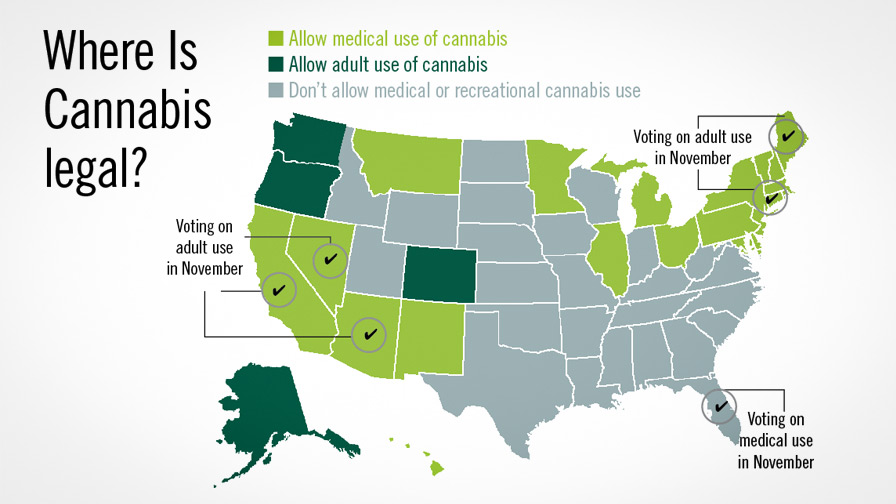Adult Use Of Cannabis On The Ballot In 2016

Up to five state initiatives that would legalize adult use of cannabis — and another that would approve medical uses — are likely to be on ballots this fall. Come Nov. 9, more than half of U.S. states may allow some form of legalized cannabis. While such numbers may have seemed unthinkable not so long ago, they appear to be in line with the sentiments of the country as a whole. According to a June 6, 2016, Quinnipiac University national poll, 54% of Americans favor the legalization of cannabis, and 89% say they approve of legalized medical marijuana.
“Those are important numbers to recognize,” says Taylor West, Deputy Director of the National Cannabis Industry Association. “I think some people still view this as a controversial sort of thing. The reality is the majority of Americans now recognize the way we have been treating cannabis is a failure and that legalization efforts that include taxation and regulation are a much smarter way to go.”
Following Pennsylvania’s approval of medical cannabis in 2015 and Ohio’s legislature following suit in June 2016, 25 states and the District of Columbia have legalized cannabis in some form.
Most of the state initiatives that could approve adult use of cannabis this November are not yet finalized, but according to West, there are five where it seems most likely to happen: California, Arizona, Massachusetts, Maine, and Nevada. Florida voters are likely to vote on a constitutional amendment that would allow expanded medical uses, as well (see Cannabis Cultivation Quest Becoming Reality For Florida Nurseries).
California, Arizona, Massachusetts, Maine, and Nevada each have existing medical cannabis programs. That raises the question of whether successful implementation of a medical program can eventually lead to expanded uses. West thinks it could.
“It’s not a straight line, but when people see the large number of benefits and the small number of drawbacks to a medical program, they generally are more open to finding ways to increase access within that program and also to considering the possibility of adult-use legalization,” she says.
Other states seem to be in the mix for broader legalization, as well — if not this fall, then in the coming months. Vermont and Rhode Island have both been considering opening up to adult legalization via their legislatures, West says.
“It would be the first time that a state has done that by elected body rather than through a voter initiative. Those are two to keep an eye on,” she says.
Federal Policy Evolving
But even as more states legalize cannabis, many potential producers who might like to jump in, including ornamental greenhouse growers, remain on the sidelines due to the uncertainty around conflicts with federal cannabis laws and policy. But there are signs that the federal government has been considering some changes of its own.
Both presidential candidates appear to be open to expanding the use of medical cannabis, or at least don’t seem to be anxious to interfere with the programs states have put in place. And the U.S. Drug Enforcement Agency (DEA) may take action even before the election.
“A lot will depend on what happens in June when the DEA takes a stance on cannabis,” says Tyler Dautrich, co-founder of Greenhouse Ventures LLC, a business accelerator specific to ancillary startups in the cannabis industry. “They have said they are going to make an announcement about whether they will reschedule cannabis from a Schedule 1 drug [defined as a drug with no currently accepted medical use and a high potential for abuse] to a Schedule 2 drug [a category of highly regulated, sometimes legal, drugs, ranging from Vicodin, oxycodone, and Ritalin to cocaine and methamphetamine]. I think the DEA decision, in addition with the outcome of individual states voting on legalization — medical or recreational — will play a major role in what the federal government decides to do in 2017.”
Such a change would have pros and cons, Dautrich says.
“On the plus side, reclassifying it as a Schedule 2 drug would open up cannabis to more medical research. The industry would have validation that cannabis can provide medical benefits for a number of illnesses and conditions. However, I have been hearing from lawyers that it could create issues for adult use because there’s not a legal ‘recreational’ industry for any current Schedule 2 drugs,” he says.
Federal legislation that makes life easier for cannabis businesses could be on the way, as well.
“I think Congress has found something they agree on and there have already been some interesting bipartisan bills that have passed or are on the table,” says Dale Sky Jones, Executive Chancellor of Oakland, CA’s, Oaksterdam University, which provides training for the cannabis industry.
A few things need to change quickly to allow business owners to survive in states where cannabis is legal, she says, including access to banking and reforming tax laws. Current IRS rules, for example, disallow all normal operating business expenses from being deducted by cannabis producers.
“That is crippling for any business. Imagine not being able to deduct the cost of your employees, overhead, or rent. I can’t think of a business that could survive under those tax rules in the U.S. So there are still things that need to be fixed and there is still genuine risk for these companies,” Jones says.
The Law Of Unintended Consequences
While legalization of medical and adult uses would seem to be a significant opportunity for greenhouse growers, it also could open the door to much bigger competitors than the greenhouse down the road. Large pharmaceutical and tobacco companies will certainly be watching for opportunities in a more open regulatory environment.
“There is, of course, concern and the lobbying muscle they have is frightening to contemplate. But you also have to realize [federal legalization] is probably not going to happen with a bang but with a whimper,” Jones says. “I don’t know that enough gears will turn simultaneously to really blow anything wide open before 2020. So we have a small window of time between now and then. It’s the little things here and there that create the pockets of opportunity [for smaller producers] we just have to keep pushing for.”
One of those opportunities, Dautrich suggests, is branding.
“What’s going to help you last when big money comes into the situation is having a reputable brand name that customers are loyal to and trust and always come back to. That’s why you see both medical and recreational companies now trying to make that push to get into as many markets as they can outside of their own state,” he says.
But that’s the future. Here in the present, public opinion indicates that some fairly significant changes may be coming as soon as this fall’s elections.
“Nationally, polling is very clear at this point that really the only demographic group that is clearly opposed to cannabis legalization is people over the age of 65. In presidential election years, you see the higher youth voter turnout. You get a more diverse electorate, and that typically is going to work in favor of cannabis initiatives,” West says.









